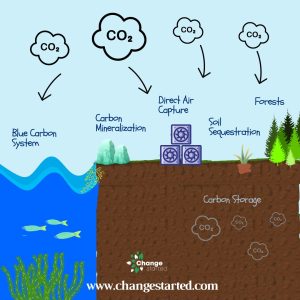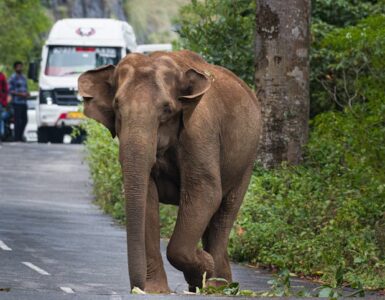Ever since the Industrialization revolution kicked in, manufacturing, transportation, and power generation have rapidly increased the concentration of greenhouse gases in Earth’s atmosphere.
These heat-trapping greenhouse gases have warmed the planet to a considerable degree, causing global warming and impacting the lives of millions worldwide.
To achieve a global temperature reduction, the world has to stop greenhouse emissions and remove the emissions that already exist in the atmosphere.
If we hope to avoid more than 1.5 degrees Celsius of global warming, the amount of emission extracted from the atmosphere must be greater than the amount that enters the atmosphere.
In 2018, the United Nations’ Intergovernmental Panel on Climate Change (IPCC) mentioned that human society must remove 1 trillion tons of carbon by the end of 2100.
While planting trees and increasing the forest cover manifold could help in carbon removal, that process is slow and has risks and challenges.
Moreover, not all emissions can be eliminated due to population and urbanization; few economic sectors will continue to leak emissions. For example, methane from animal agriculture; despite the best efforts from the plant-based meat industry, it will be difficult to change people’s dietary preferences completely. Cement, steel, and aviation sectors will need more time to reduce carbon emissions.
Therefore, in addition to the natural processes, we need accelerated carbon removal efforts through technological means. In line with this thought, carbon capture and carbon sequestration technologies have emerged as a medium that pulls carbon from the atmosphere and stores it for a long time. Leveraging these technologies will be essential to achieving net-zero carbon emissions, which many countries have announced.
Is there a difference between Carbon Capture and Carbon Sequestration? Yes. Sometimes, Carbon capture and Carbon Sequestration are used interchangeably; however, there is a difference between these terms. Carbon capture is the process of catching carbon dioxide from the atmosphere, while carbon storage or carbon sequestration is referred to as storing carbon for a long period.
Different types of Carbon Capture and Carbon Sequestration technologies
The sector is still evolving, and different carbon capture and carbon sequestration technologies are being researched to extract and store the maximum possible amount of carbon dioxide from the atmosphere to stabilize global temperatures.
Many methods to remove and store carbon are part of these efforts, such as reforestation, soil sequestration, direct air capture (DAC), carbon mineralization, and ocean-based carbon removal, among others.

Reforestation and Afforestation
For the last millions of years, forests have played a critical role in regulating Earth’s temperature by capturing the carbon dioxide from the atmosphere and releasing oxygen. However, massive deforestation due to agriculture, industrialization, and urbanization has shrunk most of our forests.
Therefore, efforts are being made to revive, restore, and expand our forests. From planting seeds through drones to manual methods of planting trees, it is underway in many parts of the world. The added benefit of growing forests is the revival of biodiversity, flora, and fauna.
Though forest restoration is comparatively cheaper than other carbon removal methods, it takes time for forests to grow. In addition, forests are vulnerable to wildfires, which create more damage as they release carbon dioxide into the atmosphere.
Soil Sequestration
Carbon is stored naturally in soil by plants through photosynthesis. Researchers are making discoveries to increase the ability of soil to sequester carbon.
One of the methods of soil sequestration is microbial seed coating, which enhances a plant’s ability to store carbon in the soil. When farmers plant coated seeds, the ensuing plant has a better capability to store carbon in the soil and also increase soil health.
Direct Air Capture (DAC)
Direct Air Capture is an evolving carbon capture technology that involves extracting carbon out of the ambient air and permanently storing it underneath the Earth’s surface.
Compared to carbon capture technologies that are located close to carbon-emitting sources like a factory or a power plant, direct air capture can be located anywhere. Typically, they will use gigantic electric fans to remove CO2 directly from the atmosphere using chemical compounds that bind to the CO2 and then store them beneath the Earth’s surface or use them to make other products.
DAC methods need high capital expenditure and are also dependent on an enormous amount of external energy. Therefore, if the energy source is not renewable, it defeats the purpose of carbon capture.
Carbon Mineralization
Carbon mineralization is a natural process where some minerals react with carbon dioxide and mineralize. This natural mineralization process can take hundreds of years to accomplish.
Discoveries have been made to accelerate this process by exposing captured carbon to other natural substances, rocks, and minerals for long-term storage.
Blue Carbon
The blue carbon system refers to the carbon captured by the coastal ecosystems. Ocean-based carbon capture techniques envisage leveraging this natural process of oceans and seas.
Researchers and companies are trying to accelerate the ability of coastal plants, seaweed, and other marine species to extract carbon and store it in deep ocean beds.
Ocean restoration through natural means also helps in the revival of marine ecosystems.
Biochar
This process transforms the carbon in the biomass into a stable, solid form that can be stored in the soil for long periods, potentially hundreds to thousands of years.
If the organic material is left to decompose naturally, it releases carbon dioxide into the atmosphere. However, during the pyrolysis process that creates biochar, a significant portion of the carbon in the biomass is “locked” into the charred form, preventing it from being released as CO₂.
Another advantage of this process is that when biochar is added to soil, it improves soil fertility, water retention, and microbial activity which has the potential to support sustainable agriculture.
Wrapping Up
Looking at the potential of carbon removal technologies, especially DAC, many large corporates like Google, Facebook, Microsoft, Stipe, McKinsey, BCG, UBS, and Swiss Re, among others, have made investments and commitments in the sector.
On the other hand, sceptics are not sure about the long-term consequences of many of these techniques. They fear that if carbon capture becomes the only medium to fight climate change, other decarbonization strategies like renewables might take the backseat. The costs associated with carbon capture technologies are also currently high, which limits their wide acceptability.
Carbon Capture and Carbon Sequestration have potential, but they cannot be called magical solutions to our climate woes. We need to work with these technologies along with all the other efforts that are required to address the climate.
If you want to know about some of the companies that are working in carbon removal areas, here is an article you can refer to.






Add comment